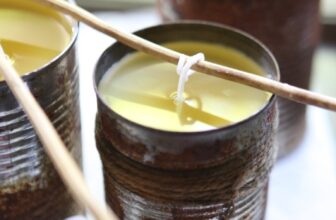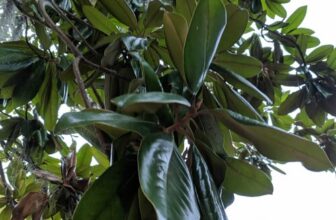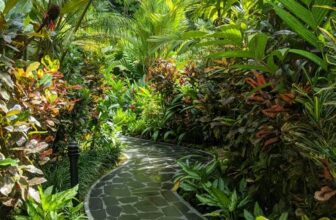Garden screening plants are a speciality at Architectural Plants. ‘It’s what about 90% of our customers want,’ says Guy Watts, the company’s MD.
So I asked him how to choose the right plants, how to avoid mistakes in garden screening and his top seven garden screening plants.
Guy advises ‘layering’ your plants rather than planting a hedge all round the boundary. This avoids the heavy look of a tall hedge and gives you far more choice of plants.

Mix or ‘layer’ your garden screening plants to provide stylish and effective cover.
How Garden Screening Plants Can Help
The most common reasons you may want privacy include:
- Privacy from neighbours’ windows
- Blocking unsightly views, such as commercial buildings, street lights or upcoming developments
- Creating private garden ‘rooms’, for example: screening a pool or terrace or dividing up the garden to protect from wind
- Improve the privacy of your home, such as screening downstairs windows from passersby on the street

Two standard hollies give privacy to downstairs office windows. They’re smart and easy care – a once-a-year clip will keep them in shape.
Decide What You Need to Screen
Tall hedges around your boundary won’t give you the best or most effective screening. Guy says it’s better to layer different plants throughout the garden for a more interesting design.
Before choosing garden screening plants, think about:
- Height required — Measure the fence or wall height and work out how tall the plant must be above it. (Note: check any local or national rules or laws that may apply).
- Distance from the house or area you want to screen — The nearer the screen is to you, the shorter or smaller it can be while still blocking a view.
- Evergreen or deciduous — Evergreen gives year-round coverage. Deciduous trees and shrubs lose their leaves in winter, so they let in more light. A few deciduous trees, such as beech or hornbeam, keep most of their leaves so you still get some screening, although it won’t be green.

This archway at Architectural Plants frames a gazebo and screens the area around it. This is hornbeam, which is deciduous, meaning its leaves die in winter. However, they stay on the tree until spring, creating a smart bronze screening effect.
Planting Position and Boundaries
Guy advises planting far enough away from the fence or boundary so you can access all sides of your garden screening plants for maintenance.

Eleaegnus ebbingeii on a pleached screen is one of Guy’s favourite garden screening plants. This is evergreen and will give you year round privacy, but you will need access to both sides to keep it trimmed in shape. Plant it just a few feet away from the fence line, so you can access both sides.
And remember – you don’t necessarily even need to be close to the fence or boundary to screen effectively.
In my book The Complete Guide to Garden Privacy, I explain the principle of interrupting sight lines. If you can see someone or something in a window over-looking your garden, they can see you. If you can’t see them (perhaps the window is at an angle), then they can’t easily see you.
So you only need to screen the area that overlooks you. This is where choosing the right shape of tree or shrub makes a big difference.
Layering makes the garden feel more interesting and natural. It avoids a solid green barrier and makes your garden screening a positive part of the design.
Start with the First Layer
Pots and planters on a deck or terrace create the first layer of privacy. They soften the space and add seasonal colour close to the house.
Add Medium-Height Plants
Hedges don’t need to be tall – 5ft-6ft high is all you need close to a windows, decks, or along the base of a wall. These also help disguise unattractive features, such as a garage wall.
Use pleached trees if you want a higher length of screening without taking up too much space on the ground.
Introduce Taller Trees
Choose taller plants where extra height is needed. Columnar trees work well to block a single sight line. Create drama by placing 2, 3 or more in different spots around the garden.
Round-topped “lollipop” trees add a smart topiarised look and are also good for blocking a single sight line. Pair them for a classic feel, on either side of a gate or door. Mix the round-topped trees with the tall thin ones for interesting variations and texture.
Don’t forget – planting in the middle of a garden can also make the garden seem bigger because the eye doesn’t go straight to the perimeter. It takes you time to look up and around.
It’s a useful trick if your garden is shallow, for example. Plant a tree or trees in the middle to interrupt your eye. Find out more about this in How to Turn a Wide Shallow Backyard into the Perfect Garden.
Always check local regulations before planting. You may need permission if you live in a conservation area, own a Listed property, or if Tree Preservation Orders (TPOs) apply.
Guy’s 7 Favourite Garden Screening Plants
When choosing garden screening plants, remember that there is always a trade-off between getting good cover quickly and long-term maintenance.
‘Plants that grow quickly will need clipping more often,’ warns Guy. Slow-growing plants will either take longer to get to the size you want or will cost more if you buy them bigger.
For a Neat, Architectural Look
- Pleached Trees – The tree head is wired to flat-topped frames that can be clipped to sit neatly above a fence without taking up much space. Line them up together to create a ‘hedge on stilts’.
- Standard Trees (‘lollipops’) – Single stem with a rounded head. They can be loose and natural or clipped and formal like the two hollies above.
- Fastigiate – very tall thin trees which take up very little space on the ground and don’t block much light. They’re naturally narrow because their branches grow upwards, almost parallel to the stem. The Italian Cyprus is the best known but you can also get other tree varieties, such as Liquidambar ‘Slender Silhouette’.
- Multi-stemmed trees – beloved of the garden shows, multi-stem trees fan out with several stems from the base. They don’t grow as tall as the same type of tree would be with a single trunk.
- On a Frame – the whole tree is espaliered onto a frame from the base.

Magnolia grandiflora on a frame, screening a deck at Architectural Plants. The magnolia is secured to the frame from the base upwards and then clipped regularly to give even coverage from the top to the bottom.

Liquidambar ‘Slender Silhouette’ – a graceful and slender ‘fastigiate’ tree which will give you outstanding autumn/fall colour.

Amelanchier (Sugar Plum) as a ‘multi-stemmed tree.’ Multi-stemmed trees give you more planting space on the ground and a nice layer of screening where you need it. Amelanchier has spring flowers and good autumn foliage. Multi-stemmed trees don’t usually grow as high as their single-trunk versions.
Recommended Evergreen Varieties
- Portuguese Laurel (Prunus lusitanica)
- Evergreen with attractive red stems
- Fast-growing for quick results
- Clips neatly into shape twice a year
- Holly (Ilex aquifolium)
- Evergreen with winter berries
- Very slow-growing — minimal trimming needed
- Works well as a feature tree or in large pots
- Privet (Ligustrum japonicum)
- Grows well in almost any soil.
- Evergreen and fast-growing, can be shaped easily but can lose some leaves in a hard winter
- Needs clipping 2-4 times a year.
- Elaeagnus ebbingeii
- Very tough, can cope with wind or salt spray and almost any soil.
- Will even grow in shade, although more slowly
- Evergreen and fast-growing, can be shaped easily
- Needs clipping 2-4 times a year.
- Autumn flowers and winter berries
Recommended Deciduous Varieties
- Hornbeam (Carpinus betulus)
- Deciduous but holds brown leaves into winter
- Tolerates most soils, even clay
- Needs just one trim a year
- Liquidambar styraciflua
- Deciduous with stunning autumn colour
- Tolerates shaping on a frame for formal screening
- Generally one annual prune is enough
- Multi-stemmed Amelanchier
- Deciduous with stunning autumn colour
- Spring flowers and bright green summer foliage
- Rate of growth is moderate: one annual prune is enough

Liquidambar on a frame to screen from the ground up. Trim it like a hedge, probably around once a year.
Screening in Pots for Small Gardens
If you’re renting or you have a small space, such as a deck or balcony, you can grow garden screening plants in pots.
Always buy the largest pots you can afford or fit into the area. Tree roots need space!
- Bamboo works well in pots (but is too invasive for open ground). ‘People may say that the clumping varieties of bamboo don’t spread, but I think all bamboos are invasive,’ says Guy.
- Standard or pleached trees can be grown in pots. It’s particularly important to choose large, wide pots with a stable base for these trees. If the pot is too tall or narrow, the heads of the trees will catch the wind and can act like a sail, tipping the pot over.
- All trees and shrubs in pots need regular watering. They won’t access much rainwater from the pot.
- Use good drainage and mulch to keep roots cool in summer.

Get the biggest pots you can for screening trees! Tree roots need lots of space for water and nutrients.
How to Plant & Care for Garden Screening Plants and Trees
If budget is important, plant bare-root or root-balled hedging between autumn/fall and early spring.
‘Bare-root’ trees and plants are grown in the soil, then dug up for sale when they are dormant in winter. The root ball will be bagged up in something like a hessian sack.
Bare-root plants are cheaper because growing in the ground is less work than growing in pots.
Container-grown trees can be planted all year, but will cost more.
And if you plant trees or shrubs in summer, you will need to water it more than at other times of year. Summer is hotter and drier, so plants will need more help to get going.
Watering and Aftercare
- First 18 months to 3 years are critical, says Guy — water regularly in dry weather.
- Consider installing irrigation, which is often allowed even in hosepipe bans. Irrigation still needs management – don’t just set it and leave it!
- Use mycorrhizal fungi at planting to encourage root growth.
- Mulch annually to retain moisture, but keep mulch away from the stem to avoid rot.
Mycorrhizal fungi is It helps roots establish in your soil. I’ve used both Empathy Rootgrow and Envii Rootwell successfully. Note that links to Amazon are affiliate, see disclosure.

Italian Cyprus is one of the most popular fastigiate garden screening plants. Its tall pencil shape adds distinction to any garden.
Fertilizing garden screening plants
Some companies, such as Architectural Plants, sell their container-grown nursery plants come with slow-release feed in the compost. This will help the plant through its first season.
If you’re planting bare root plants, then Guy thinks the microrrhizal funghi is more important.
You won’t need to fertilize your trees and hedges if you keep your soil in good condition by adding a yearly organic mulch, such as well rotted garden compost or manure.
However, be careful not to cover the tree trunks or stems in the compost. This will cause the tree to rot, explains Guy. ‘Spread the mulch over the soil, but keep it clear of the base of the tree.’ (The mulch will decompose as worms and soil organisms take it into the soil, so it won’t get higher every year.)
After the first year, feed only if the plant looks stressed — yellowing leaves, poor growth, or leaf drop.
Pots, of course, will need regular feeding. They have no access to nutrients in the soil. (for more about this see Your Best Pots Ever – 6 Tips for Brilliant Container Gardening.)
Avoid These Common Screening Mistakes
- Choosing a plant that will grow too tall. Most good screening plants can be kept under control with regular pruning, but reducing the height of a tree isn’t always as simple as chopping off the top layer. See What You Need to Know Before You Call In the Tree Surgeon.
- Planting too close to a fence so you can’t prune properly.
- Letting mulch or soil bury the base of the stem.
- Expecting the clear stem height to increase — trees don’t grow up from the root, they just grow up atthe top so your bare area of trunk will stay the same.
More On Garden Privacy
You may also find these posts valuable if you want to increase your garden privacy. Plus a bonus post about Architectural Plants’ other speciality – blobberies!
How to Increase Your Garden Privacy – answers to the three top questions on privacy.
New Directions in Garden Privacy Screens – using stylish wood, metal and built privacy screens and shelters.
Fences for Privacy – garden screening with fence materials and styles
How to Prune Garden Trees for Privacy and Light – for beautifully shaped trees that are light and airy.
More About Perfect for Privacy Trees – if you’re just choosing one tree for the right spot
What Is A Blobbery – Why Your Garden Needs Balls, Lollipops and Clouds – more inspiring advice from Architectural Plants who coined the term ‘blobbery’ and now we all want one.
Pin to remember garden screening plants
And do join us. See here for a free weekly email with more gardening tips, ideas and inspiration.





